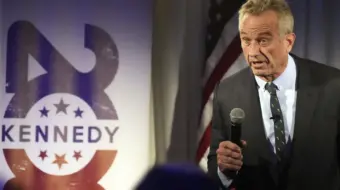
NEW YORK — This wasn’t your usual trip to the library. At New York University’s Tamiment Library, March 23, people jammed in to sit on folding chairs or stand shoulder-to-shoulder and listen to speakers tell of the Communist Party USA’s contributions to American labor and democratic rights. The crowd studied display cases full of photos, buttons, leaflets and letters from the 2,000 boxes of archives donated by the Communist Party to the Tamiment, which specializes in left and labor history.
Labor and civil rights historians, Communist Party leaders, librarians, peace activists, elected officials and trade unionists celebrated the gift, which includes 1 million photos from the archives of the People’s Weekly World and tens of thousands of books and pamphlets.
The archives include Joe Hill’s will and his goodbye letter to “Rebel Girl” Elizabeth Gurley Flynn. The crowd heard comments by African American scholar and activist W.E.B. Du Bois from the archives’ audio collection, and watched a piece of a film on the 1926 Passaic, N.J., textile strike. The film is the only complete copy in the country and will be preserved by the Library of Congress with copies available at Tamiment.
“It’s going to take us years before we know everything in those boxes,” Tamiment Library director Michael Nash said. The donation will spawn a whole new generation of historical scholarship exploring a people’s history, he said.
Rutgers University professor Norman Markowitz called the CPUSA a “party of hope,” borrowing a term used for pre-Civil-War activists who “fought for free schools, prison reform, asylums for the mentally ill, and most of all the abolition of slavery.”
Markowitz said CPUSA leaders and members “built the first real integrated political party in American history, as they developed mass organizations like the National Negro Congress, the Southern Negro Youth Congress and the Civil Rights Congress,” which “made a central contribution” to placing civil rights “on the political agenda.”
Steve Kramer, executive vice president of Service Employees Union Local 1199, spoke of the party’s role in building and maintaining his union.
Recounting 1199’s “disastrous” 1984 strike and internal strife in which “the union almost tore itself up,” Kramer said that but for the party’s efforts, “1199 would have been a small union.” Today, with nearly 300,000 members, it is the world’s largest union local.
New York State Sen. Bill Perkins told how during eight years in the New York City Council, he sat in the seat once occupied by Communist Councilman Ben Davis, who never lost an election but was removed from office in chains under the McCarthyite Smith Act.
“His record in the council,” Perkins said, “is one that many of us are still trying to live up to, because he was among the first to champion laws for workers, for housing rights and for civil rights in the City Council.”
Leslie Cagan, a leader of United for Peace and Justice, the national anti-Iraq-war coalition, said of the party’s peace activism, “We have so much to learn from the history of the Communist Party about how this work has been done.”
The presence of dozens of party and Young Communist League members in the crowd indicated that the Communist Party continues to be an important and growing part of the American political scene.
New York State Assemblyman Richard Gottfried spoke humorously of representing a district that includes Manhattan’s Chelsea neighborhood where the Communist Party has its offices.
“Is Estelle Katz here?” Gottfried asked, looking for the well-known Chelsea retiree and Communist peace activist. “My district may be the most unique in the nation where the ‘red-baitees’ out-number the ‘red-baiters,’” he said.
The party has a great past, PWW editor and CPUSA leader Teresa Albano said, but “we are part of the present and future.”
“We are making the promise of America real for everyone,” she said, citing the party’s involvement in current battles against the extreme right, racism, sexism and war, continuing the fight for peace, equality and socialism.
While articles on the archives in The New York Times, New York Post and others called the party an agent for the Soviet Union, CPUSA Executive Vice Chair Jarvis Tyner demolished these claims.
“I have been in the party for 47 years, and in the leadership for 40 years and I can tell you that I’ve never gotten an order from Moscow,” he said.
Tyner outlined the fascist-like provisions of the McCarran Act, passed by Congress in the late 1940s — over Truman’s veto — and later struck down by the Supreme Court as unconstitutional. He also described the influence of European and U.S. Communists in developing the popular “united front” policies against fascism and war.
“So maybe it should be said, we didn’t take orders from Moscow — Moscow took orders from us,” he said.
As supposed evidence of ties to Moscow, the Times article cited documents in the archives in which party members had coded their messages. Tyner noted that in its early days the Communist Party was illegal, like union organizing and racial integration. But Communists organized for unions and against racist terror and segregation. So “powerful financial interests were against them,” Tyner said. “They faced labor spies, provocateurs, KKK terrorism and government thugs. Thousands were rounded up, jailed and many deported in the Palmer raids of the 1920s.
“Those comrades wrote in codes,” Tyner exclaimed. “It would have been foolish not to!”
Among the historians who spoke were American Communist History editor Daniel Leab and University of Houston professor Gerald Horne. The event was co-sponsored by the Labor and Working Class History Association.
Pregones, a Latino theater group, performed part of a recent production “The Red Rose,” based on the life and writings of Puerto Rican and Communist Party leader Jesus Colon.
Afterward, Nash told how he had grabbed a random box to show the Times reporter, and found letters written by Colon to the New York Board of Education lobbying for bilingual education in the 1940s and ’50s. The reporter was “blown away,” he said, saying she thought this was a 1980s and ’90s issue.
“But a Communist, Jesus Colon, advocated for it decades before,” Nash said.
dmargolis @ pww.org











Comments